Materials. Introduction
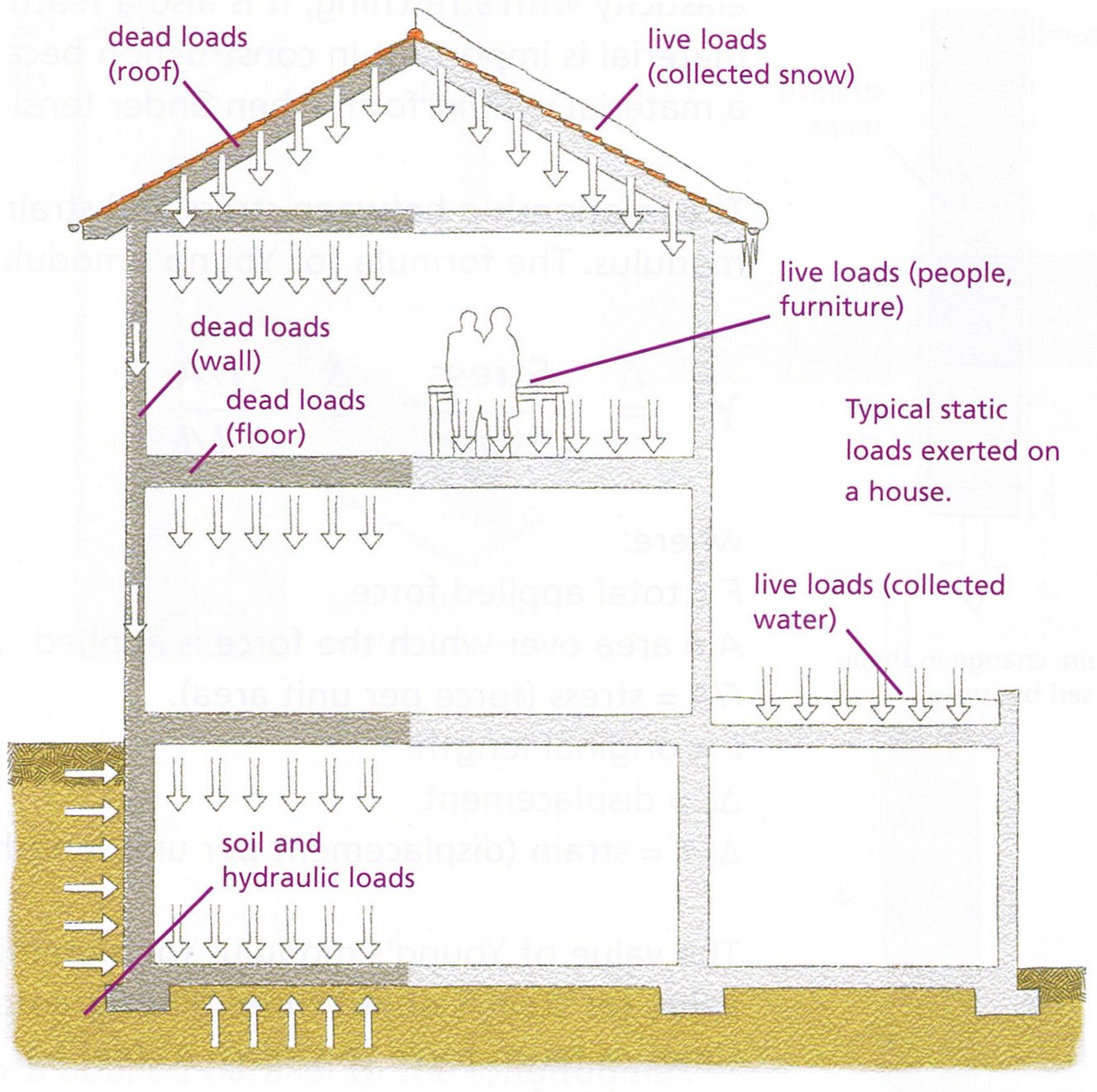
- Structureis comprised of pillars, beams and tie-beams made of reinforced concrete or iron.
The structural system of every house is required to support and transmit various loads. These Loads can be classed as static or dynamic.
In houses, the structural and enclosure systems ( external and internal walls ) are sometimes integrated. For example, the external walls of a typical 1920 “extremadura” house serve as both the structural and enclosure system.
Static Loads:
Loads that are applied slowly to a structure and do not change quickly. Examples of static loads include:
Dynamic Loads.
Loads that are applied suddenly to a structure, often with rapid changes in magnitude and point of application
- Floors and ceiling.
The primary functions of the floor are to support the imposed loads and to provide a level surface for the activities that are carried out in the home.
Floors must be designed to meet a number of performance requirements, including:

A typical Spanish Home uses hollow tiles to withstand both live and dead loads. Made of clay or concrete, they are placed between two tie-beams. It is very easy to install as you only have to put it between two tie-beams. Later, cover with a concrete layer which could contain a iron wire netting (see next illustration).
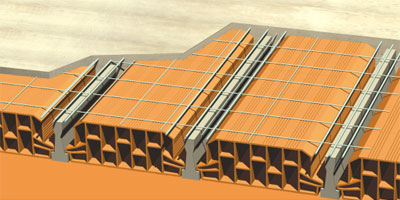
The hollow tile is later coved by a layer of concrete. Floors are finished with floor tiles or boards.
Exteriors walls
The primary functions of the external walls of a house are to support the loads generated ( only in case of a no-columns structure ) and to create a comfortable living space. Walls must be designed to meet a number of performance requirements including: 1st Strength and Stability — The strength and stability of an external wall depends on: — the strength of the components used (E.g. blocks, mortar)
— Slenderness Ratio — tall, thin walls are less stable than short, thick walls
— Eccentricity of the applied load — the force experienced by the wall from above must be centred.
Bonding is an essential design feature of masonry walls and greatly improves the strength of a wall by ensuring that it performs as a continual unit. Bonding is defined as the overlapping of blocks or bricks to ensure that the vertical and lateral loads are dispersed evenly throughout the wall. See photo below

2º Weather Resistance — Designing for weather resistance is mainly about preventing the penetration of 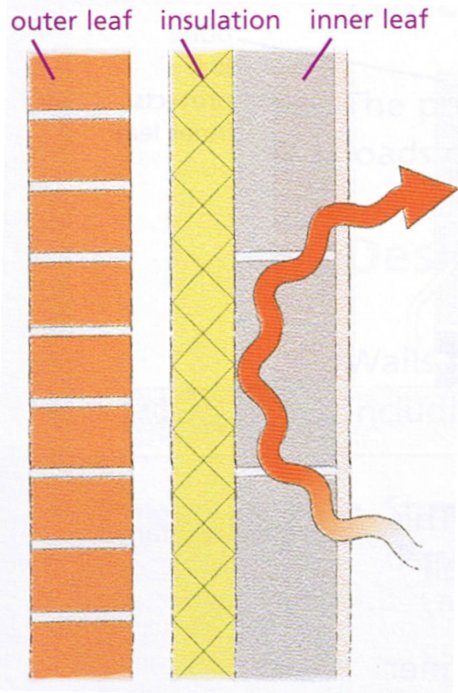 wind-driven rain.
wind-driven rain.
The most t common method used for housing is the cavity construction. This involves building a wall that consists of two separate walls, an inner wall and an outer wall, with a small gap ( called a cavity ) between them and another bigger gap for an insulator. The cavity prevents the moisture absorbed by the outer wall reaching the insulator and the inner wall. The inner and outer walls used in construction are normally referred to as the inner leaf and the outer leaf.
The function of the outer leaf is to protect the inner leaf from the effects of weathering. The function of the inner leaf is to support the loads of the house ( Only in traditional houses. Nowadays, in modern houses and buildings, the columns support the loads ).
3 rd Thermal Insulator. The proper thermal insulation of walls is essential to ensure that heat is not lost from the home. Poor thermal insulation leads to greater fuel use which in turn is damaging to the environment and expensive for the home owner. Masonry cavity walls are usually insulated by placing a continuous layer of rigid expanded polystyrene foam insulator into the cavity. This insulation board is held tightly against the inner leaf. This means that when the house is heated the heat energy is absorbed by the inner leaf. For this reason it can take some time for a comfortable temperature to be achieved. However, once warm, concrete cavity-walled homes can remain so for several hours after the heating is turned off, as the concrete inner leaf acts as a heat store.
Windows:
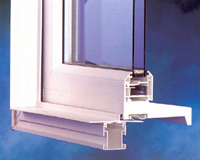 The primary functions of a window are to admit light and fresh air into a building. Light and fresh air are essential to a healthy space. The big problem of window is the loss of heat. The greater the window’s surface the more money you have to pay. So a proper thermal insulation design is very important. Poorly insulated, draughty windows are uncomfortable to sit near and waste heat energy. The thermal insulation of windows is achieved primarily through the use of double-glazing and weather stripping. Double-glazing is designed to reduce the amount of heat lost through the glass, while weather stripping is designed to reduce the amount of heat lost due to air infiltration (draughts). Double-glazing can significantly reduce the amount of heat lost through a typical window.
The primary functions of a window are to admit light and fresh air into a building. Light and fresh air are essential to a healthy space. The big problem of window is the loss of heat. The greater the window’s surface the more money you have to pay. So a proper thermal insulation design is very important. Poorly insulated, draughty windows are uncomfortable to sit near and waste heat energy. The thermal insulation of windows is achieved primarily through the use of double-glazing and weather stripping. Double-glazing is designed to reduce the amount of heat lost through the glass, while weather stripping is designed to reduce the amount of heat lost due to air infiltration (draughts). Double-glazing can significantly reduce the amount of heat lost through a typical window.
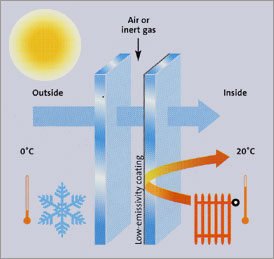
In the photo above this paragraph, a further improvement can be made by applying a special Low-emissivity (Low-e) coating to the inner pane of glass. Low-e glazing allows the short-wavelength heat energy from the sun to enter the house but acts as a barrier to the escape of the Long-wavelength energy from internal heat sources. About 60% of the heat energy lost between the panes of glass in a double-glazed window is long-wave radiation.
Roofs:
The primary functions of a roof are to protect a building from the weather and to retain the heat generated inside. Roofs must be designed to meet a number of performance requirements, including:
1st Strength and Stability — The structural stability of a roof is tested every day. The Loads exerted by the weight of roof tiles, the wind blowing against it and the additional weight of rain or snow, are considerable. • Weather Resistance — Every roof in the world is sloped to some extent. Even so-called flat roofs are slightly sloped. The reason we slope roofs is to dispel rainwater. • Thermal Insulation — To prevent heat loss the attic space of most roofs ¡s insulated with blanket (quilted) insulation.
Internal walls
The primary functions of internal walls is to divide the overall space within the house into smaller spaces. The Next photo shows the electrical circuit and plumbing.
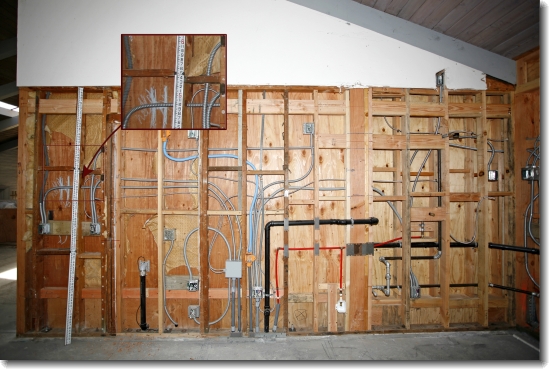
Failure: an act or instance of failing or proving unsuccessful; lack of success.
Moisture: wetness caused by water
Rot: to deteriorate, disintegrate, fall, or become weak due to decay
Slenderness: thin or slight
Masonry: work constructed by a mason, stonework or brickwork
Mason: a person whose trade is building with units of various construction products, such as stones, bricks, or tiles, usually with the use of mortar or cement as a bonding agent.
